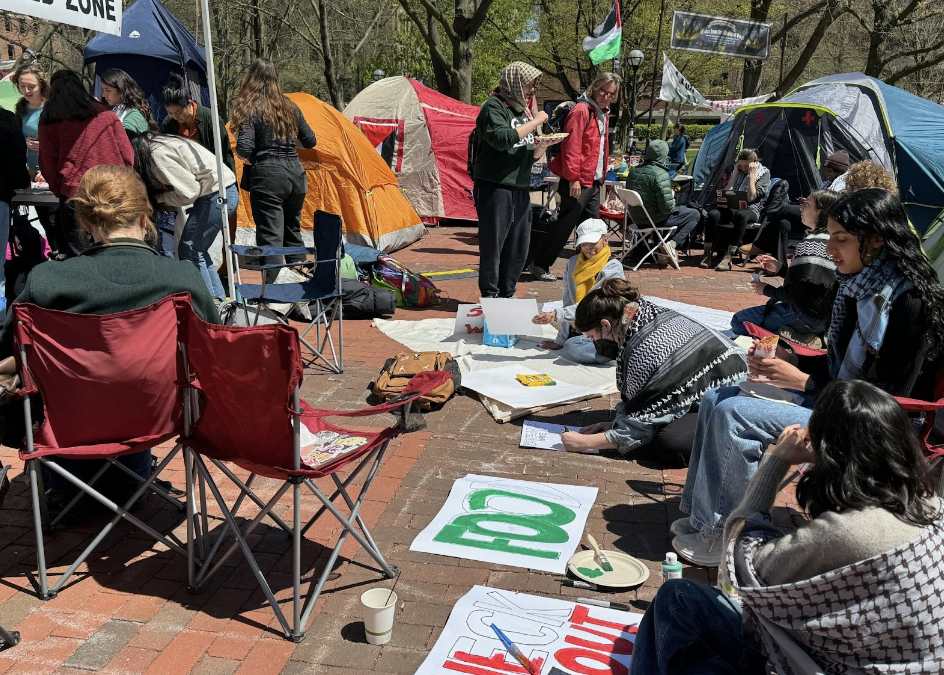The national movement for divestment reflects the prevalence of prosocial politics.
by Eugenia Quintanilla
Activism on university campuses against U.S. investments in Israel has skyrocketed in the past several weeks. As of May 2, over 90 college campuses had Gaza solidarity encampments demanding university divestment from companies supporting Israel. Despite the historical precedence of campus activism on foreign policy matters (see opposition to the Vietnam war, South African apartheid, and the 2003 U.S. invasion of Iraq), there is public confusion about the popularity, depth, nature, and size of the university divestment movement. Onlookers blame the prevalence of pro-Palestinian activism on everything from limited syllabi at top universities, peer pressure effects, and even college students not having enough sex.
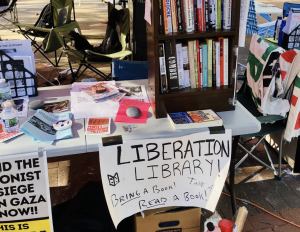 Still, there is abundant evidence to suggest that encampments represent much more than just riled up college students chanting provocative slogans. Beyond tents and sleeping areas, many encampments feature Liberation Libraries, communal art-making, and worship spaces for Jewish and Muslim participants. At the University of Michigan, students from the TAHRIR coalition have organized daily programming including teach-ins, external speaker events, documentary screenings, and broader community education initiatives.
Still, there is abundant evidence to suggest that encampments represent much more than just riled up college students chanting provocative slogans. Beyond tents and sleeping areas, many encampments feature Liberation Libraries, communal art-making, and worship spaces for Jewish and Muslim participants. At the University of Michigan, students from the TAHRIR coalition have organized daily programming including teach-ins, external speaker events, documentary screenings, and broader community education initiatives.
Student protestors and organizations have put forth specific demands and on some campuses, including Rutgers, the University of Minnesota, Brown University and Northwestern University, have reached agreements after negotiating tangible wins for the protesters related to divestment and protection of civil liberties. All of this work is happening on the heels of final exams, and commencement season, a time when college students should be the busiest. Yet activists at Emory, Columbia, UT Austin, New York University and other universities have faced brutal actions from police, violent anti-protestor attacks, more than 2,000 arrests, suspensions, and demands by political elites to call in the National Guard.
Starting and maintaining encampments is costly activism, requiring time, resources, and a willingness to endure bodily harm and legal repercussions. All of these costs should in principle reduce the likelihood of activism. But activists remain steadfast to their demands and actions, despite what we may expect. How can we better understand this wave of committed activism for Palestine?
Many Americans, I argue, are driven to political action by what can be called their prosocial politics, or their disposition to help groups in need. In what follows, I show the prevalence of prosocial politics as a driver of participation and how partisanship conditions the types of groups that Americans consider “in need.”
The Politics of Helping Others
Studying what mobilizes citizens to participate in politics is a foundational question to social scientists. Traditionally, this research analyzes citizens at the level of the individual. According to the “economic model,” individuals are essentially self-interested actors, and how they understand the costs and benefits of action determines whether they will participate. In the civic voluntarism model, an individual’s level of education, money, and time also make participation more likely.
However, more recent research shows the importance of group participation norms in determining likelihood of participation. Individuals who hold a norm of helping those in need are more likely to participate in higher-cost political participation. Psychology research on prosociality echoes the importance of helping as a cultural value, and an innate human behavior. If helping others is so important to human societies, how can we incorporate the desire to help into our models of political participation?
To answer this question, I offer a new theory called the “prosocial politics model.” In this model, citizens’ participation in politics is driven by how much they see helping others as a political value. The influence of this value is particularly strengthened by clarity around which groups are in need, and which groups are in power. As such, in the prosocial politics model, when citizens encounter a political situation they make automatic appraisals about three things:
- Whether helping others through politics matters to them
- Whether the group in question needs help, and
- Whether to take political action to help a group.
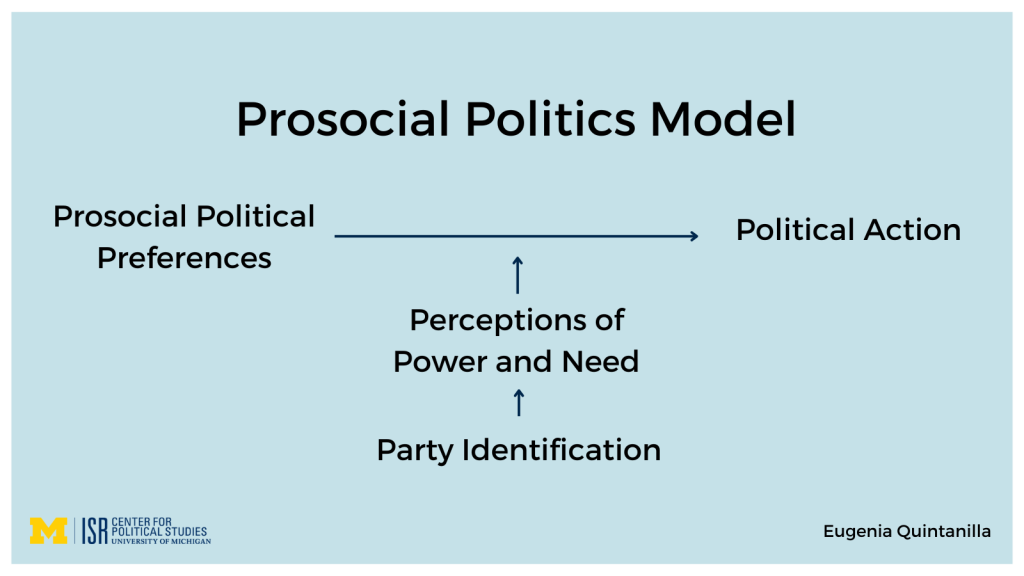
To establish evidence of the model in action, I created a measurement of prosocial political preferences in the form of six survey questions. I asked about civic prosocial norms and how helping is tied to politics in questions like, “In elections, how important do you think it is to vote in order to help others?” and “How much do you think politicians should focus on helping groups who are usually ignored?”
I fielded the prosocial political preferences questions in three separate national surveys of Americans, totaling 4,555 interviews. Across these surveys, I find that Americans on average have moderate to high scores on the scale (0.6 out of a 0-1). Additionally, I find that these political preferences are distinct from existing similar measures, such as group empathy, humanitarianism and egalitarianism, and generalized beliefs about helping others. Using a regression analysis, I find that prosocial political preferences outpace other common predictors, such as an individual’s age, their education, and their level of partisan identity strength.

Palestinians as a Group in Need
Another element of the prosocial politics model is social perception. Americans should be more responsive to a specific group, such as Palestinians, if they perceive that group to be in need– also known as the normative altruism model. Perceptions about need are not created in a vacuum. People rely on social groups to learn norms of helping obligation: the type of groups who should receive help, what the helping should look like, and the social stakes of helping. Public policy, such as welfare, also influences how we perceive the power and deservingness of groups.
In the United States, political parties heavily shape and are shaped by the social identities of their members. As a result, I expect that partisanship modifies how Americans come to perceive which groups are in need, and which groups are not. To test this part of my theory, I piloted another novel measure called the “Circles of Power and Need,” or CPN for short. The CPN measure solicits a total of 12 text answers from each survey participant, six in Power and six in Need. With a team of undergraduates, I created a coding scheme to capture the breadth and nuance in how Americans describe stratification. We used 23 characteristic categories, and assigned binary values to organize text answers from respondents.
Through this analysis, we find that Americans use multiple dimensions to discuss Power and Need. Three characteristics are the most salient across the CPN measure: Class, Race and Ethnicity, and Institutions. Americans think about power in terms of institutions, parties and ideology groups, corporations, and class. When Americans think about need, they think in terms of class, employment status and racial/ethnic groups.
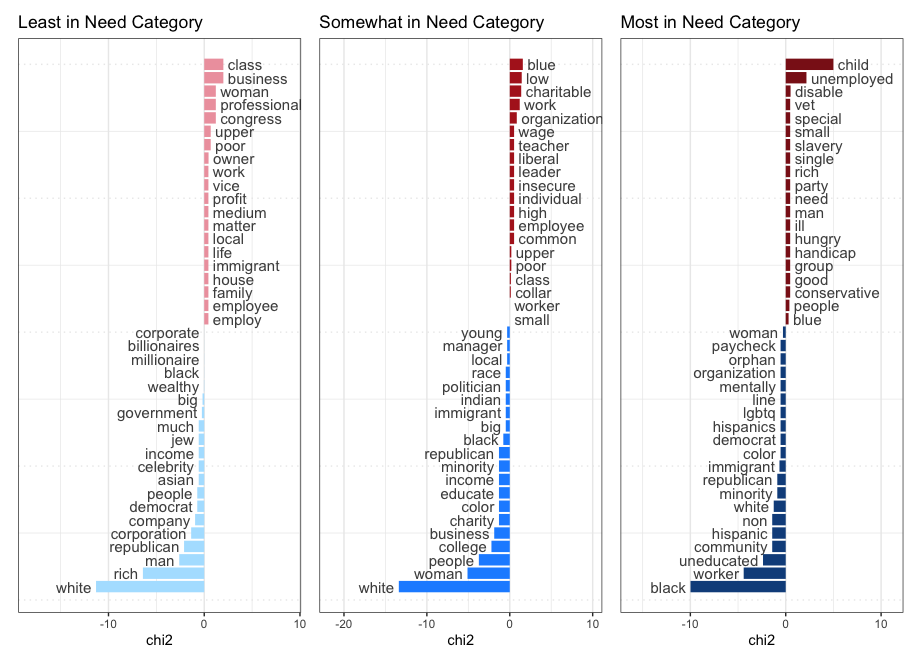
How Does Partisanship Shape Perceptions?
Democrats are overwhelmingly more likely to discuss groups in need in terms of race, ethnicity, and immigration status, while Republicans more frequently associate need with children, the disabled, and veterans. Republicans and Democrats both associate power and need with class, but Democrats reference ethnoracial and minority groups, such as Black people, White people, Hispanics, immigrants, and LGBTQ+.
The Political Consequences of Prosocial Politics
Images of Palestinian civilians killed as a result of Israeli military aggression have sparked protest, voting campaigns, and political activism. As of early May, 34,000 Palestinians have been killed by Israel’s military campaign in the past six months, including 17,000 children. Millions in Palestine are at risk of starvation as a result of alleged war crimes. Several legal experts refer to Israel’s actions as a genocide, increasing global urgency about assisting civilians at risk.
Public disagreements about the justification of Israel’s actions may not change the mobilizing effect of a steady stream of images of civilians dying, especially groups that are publicly considered more in need. Children, women, healthcare workers, foreign aid workers, educators, emergency responders, and journalists are all categories of people that are usually seen by the public as more deserving of help than other categories of people (e.g., soldiers, elected officials).
Americans protesting for the plight of Palestinians connect their cause to global justice problems like climate change, violence against indigenous populations, racism and policing. The breadth of these causes likely influences prosocial norms for Palestine, especially among youth who may have participated in the 2020 Black Lives Matter protests in their adolescence.
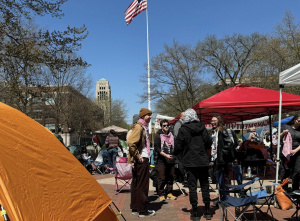 Prosocial politics may shed some light on why pro-Palestinian activism is so prevalent among young students, who are more likely to align themselves with the Democratic party, but have higher disapproval rates for Biden’s handling of the war between Israel and Hamas in Gaza in compared to their older copartisans (81% among 18-34 year olds, compared to 53% among all Democrats). In my dissertation, I also investigate how the absence of prosocial political preferences makes a difference in mobilization among individuals with different political attitudes, or issue positions. Additionally, I qualitatively study the prevalence of helping narratives in how Americans describe their own protest participation in 2020-2021.
Prosocial politics may shed some light on why pro-Palestinian activism is so prevalent among young students, who are more likely to align themselves with the Democratic party, but have higher disapproval rates for Biden’s handling of the war between Israel and Hamas in Gaza in compared to their older copartisans (81% among 18-34 year olds, compared to 53% among all Democrats). In my dissertation, I also investigate how the absence of prosocial political preferences makes a difference in mobilization among individuals with different political attitudes, or issue positions. Additionally, I qualitatively study the prevalence of helping narratives in how Americans describe their own protest participation in 2020-2021.
Student activists likely have consolidated clear ideas about Palestinians as a group in need of help, and feel morally compelled to assist them in any way they can. According to recent polling from Gall Sigler and Daniel Hopkins, younger Americans express greater sympathy for Palestinians than older Americans. This is one of many political generational divides.
For college students, demanding financial divestment from companies sustaining military action is a tactic with historical precedence. Young student activists are not alone in this conviction. Understanding solidarity activism through the lens of prosocial politics clarifies the puzzle of why so many Americans are overcoming the costs of engaging in political action– especially since protest can be an effective means of recourse for disadvantaged groups to enact political change.
Pro-Palestine activism around the world has brought the suffering of Gazans to the attention of mainstream media, setting an agenda for the upcoming presidential election. Even if campus encampments are dispersed by police, counter-protestors, or administrators, U.S. military support for Israel will likely be a salient issue for many young Americans. Future research should consider how helping others as a political value challenges common understandings of what drives political participation.
Key Takeaways:
- The prosocial politics model offers a new way to understand why people decide to engage in political action.
- Prosocial political preferences, or the extent to which people see helping others as a political value, is a powerful predictor of political action.
- Exploring the nuance in how people conceptualize others in need can clarify situations where people may or may not be driven to action.
- Partisan cues and social norms affect whom we see as people in need. Although class signifies need across parties, Democrats bring up race and ethnicity more than Republicans, who typically mention age groups, such as children or the elderly.
- Through the lens of prosocial politics, we can understand the recent wave of committed activism as motivated by a desire to help Palestinians suffering in Gaza. U.S. military aid to Israel will be a salient issue for Americans in the 2024 presidential election.
 Eugenia Quintanilla is an American Politics doctoral candidate in the Department of Political Science at the University of Michigan, and the recipient of the Garth Taylor Dissertation Award for Public Opinion– an ISR Next Generation award granted by the Center for Political Studies at the Institute for Social Research. She broadly studies political psychology, race and ethnic politics, and public opinion. Her current scholarship investigates questions about how politics and the desire to help others intersect to influence political behavior. She also studies American attitudes about wealth inequality, Latino political socialization, and racial attitudes.
Eugenia Quintanilla is an American Politics doctoral candidate in the Department of Political Science at the University of Michigan, and the recipient of the Garth Taylor Dissertation Award for Public Opinion– an ISR Next Generation award granted by the Center for Political Studies at the Institute for Social Research. She broadly studies political psychology, race and ethnic politics, and public opinion. Her current scholarship investigates questions about how politics and the desire to help others intersect to influence political behavior. She also studies American attitudes about wealth inequality, Latino political socialization, and racial attitudes.
Tevah Platt, communications specialist for the Center for Political Studies, contributed to the development of this post. Photos from William Lopez and Tevah Platt.

